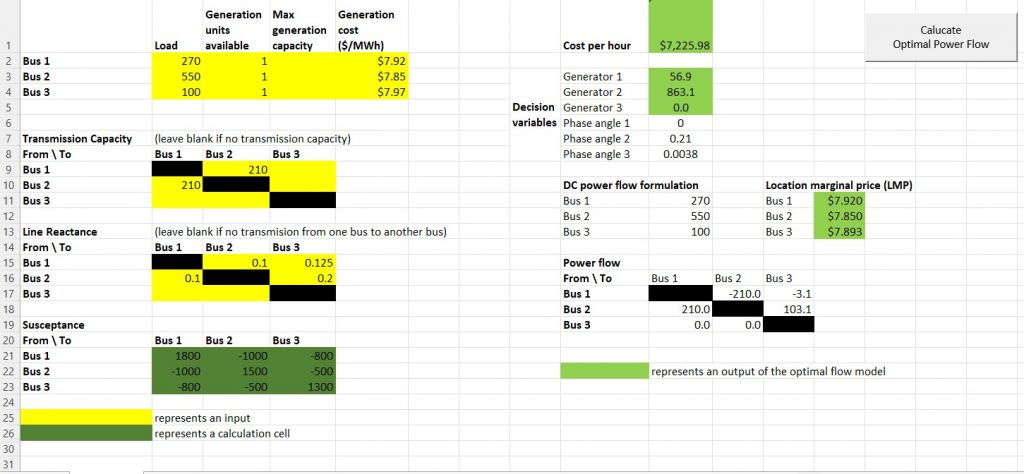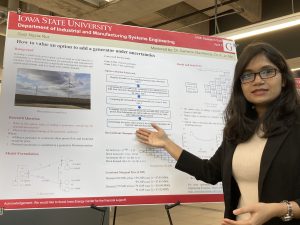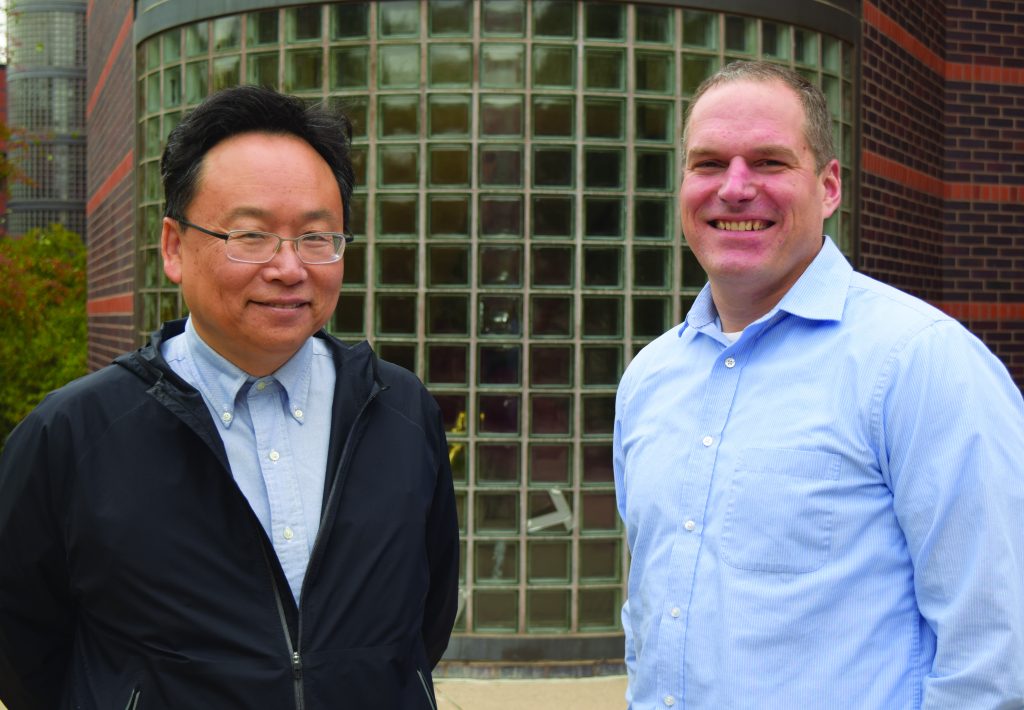Solar and Wind Energy using Engineering Economics Theory (SWEEET)
Description
The Solar and Wind Energy using Engineering Economics Theory (SWEEET) project is studying the economic viability of incorporating more solar and wind energy into Iowa’s electrical grid. The project focuses on how these renewable energy sources can better serve rural and underserved areas. This project is funded by the Iowa Energy Center. You can find preliminary results and some technical notes from the project as well as other relevant publications, more technical documents, and links to information on Iowa’s electric power network.
Download the Excel tool for optimal power flow (downloads as zip file). See teaching modules on DC optimal power flow and locational marginal price. Make sure to enable content for macros when Excel sheet opens. You will also need Solver loaded in Excel (for free).

Download the Excel tool for option valuation for 5 periods. See teaching modules on demand lattice (a model to consider uncertainty over time) and valuing an option (for new sources of electricity generation)
SWEEET 2022 Public Workshop was held on August 8, 2022. This public workshop is aimed at helping utilities and independent power producers plan strategically for the future and apply engineering economic principles when making decisions about new sources of renewable power and new transmission lines.
Introduction
Distributed solar and wind power generation planning in rural and underserved areas
- Many such generators are located in rural areas
- When new solar and wind power is added, the grid will be impacted. A lack of transmission capacity may increase electricity prices (e.g., locational marginal price)
- President Biden announced goal of making U.S. carbon neutral by 2050
Benefits of Our Approach
- Provide ratepayers with lower electricity bills
- Enable state of Iowa to be more responsive to carbon neutral targets
- Provide cleaner energy to Iowa residents
Goals of the Project
- Locate renewable generation units of right sizes at right places at right times
- Understand the ramifications and economic consequences of new generation sources on the existing grid
- Guidance to risk averse decision makers
- Produce a set of guidelines and recommendations for practitioners, academics, and decision and policy makers
More Notices:
- SWEEET was represented at the Institute for Industrial and Systems Engineers Annual Conference in Seattle, Washington in May 2022. Cameron MacKenzie presented the research on valuing options in electricity generation and planning. Xue Lei presented on designing a flexible energy portfolio for Iowa. Her conference paper can be found here.
- Public mini-workshop will be held in Ames in August 2022 to review the progress and disseminate results! To be updated soon.
- Nazia Nur won the “Graduate best poster: Third Prize” in the 10th Annual Student Research Symposium arranged by the Department of Industrial and Manufacturing Systems Engineering for her poster on “How to value an option to add a generator under uncertainties”. In this poster, she discussed the decision-making process for adding a generator considering electricity demand uncertainty.

Investigators

Jo Min, associate professor in industrial and manufacturing systems engineering (IMSE), is the principal investigator, and Cameron MacKenzie, assistant professor in IMSE, is the co-principal investigator.
Graduate Students
 |
Gazi Nazia Nur PhD student in IMSE |
 |
Jay Ghodke MS student in IMSE |
|
 |
Xue Lei PhD student in IMSE |
 |
Zhuoyi Zhao PhD student in IMSE |
MacKenzie, C.A., Vemireddy, H., & Amini, F. (2022). Leasing land for a wind turbine: A model for a farmer’s decision with risk aversion. SWEEET Public Workshop. August 8.
MacKenzie, C.A. (2021). Real options and risk aversion using the integrated valuation procedure. April 26.
Lei, X., MacKenzie, C.A., Min, K.J., & Giahi, R. (2022). Designing flexible electric generation portfolios in Iowa. Paper and presentation for the IISE Annual Conference & Expo, May 21-24.
MacKenzie, C.A., Nur, G.N., Ghodke, J.S., & Min, K.J. (2022). Optimal valuation of project options in electric power generation and transmission planning. Presented at the IISE Annual Conference & Expo, May 21 – 24.
MacKenzie, C.A., & Nur, G.N. (2022). Engineering economics applied to electricity generation decisions with uncertainty. Presented at the Iowa Association of Municipal Utilities Energy Conference, Altoona, IA, February 21.
Giahi, R., MacKenzie, C.A., & Hu, C. (2022). Optimizing the flexible design of hybrid renewable energy systems. The Engineering Economist, 67(1), 25-51. Author’s accepted manuscript. An accompanying article in ISE Magazine.
Nur, G.N., MacKenzie, C.A. & Min, K.J., (2021). Evaluating the Option Value of Adding a Generator under Demand Uncertainty: A Real Options Approach. Poster presented at the Iowa Energy Summit, November 9-10, 2021.
Ghodke, J., Nur, G.N., Min, K.J., & MacKenzie, C.A. (2021). Valuation of an Option to Expand Generation and Transmission Capacities Under Demand Uncertainty. Presented at the INFORMS ANNUAL MEETING, October 24-27, 2021.
Ghodke, J., Nur, G.N., MacKenzie, C.A., & Min, K.J. (2021). Value of a generator construction option in a transmission network under demand uncertainty. Submitted to the IEEE PES ISGT 2021 Latin America conference, September 15 – 17.
Ghodke, J., Nur, G.N., MacKenzie, C.A., & Min, K.J. (2021). Electric power planning for a transmission network under demand volatility. Presented on the IISE Annual Conference & Expo, May 22 – 25.
Lei, X., MacKenzie, C.A., Min, K.J., & Giahi, R. (2021). Designing Flexible Electric Generation Portfolios with Reinforcement Learning. Presented at the IISE Annual Conference & Expo, May 22 – 25.
Nur, G.N., MacKenzie, C.A. & Min, K.J., (2021). Value of a Generator Construction Option in a Transmission Network under Demand Uncertainty. Poster presented at the IMSE Research Symposium, April 22, 2021.
Min, J., MacKenzie, C.A., and Ryan, S.R. (2021). Life cycle costing with applications to electric energy cost. Book chapter. Maynard Handbook of Industrial Engineering, in process.
MacKenzie, C.A. (2021). Presentation on valuing real options for risk-averse decision makers
Most Relevant Publications by PI or Co-PI
Giahi, R., MacKenzie, C.A., & Hu, C. (2020). Design optimization for resilience for risk-averse firms. Computers & Industrial Engineering, 139, 106122.
Giahi, R., MacKenzie, C.A., & Hu, C. (2019). A multi-stage optimization model for flexibility in engineering design. In E. Romeijn, A. Schaefer, & R. Thomas, eds., Proceedings of the 2019 Industrial and Systems Engineering Conference. IISE Annual Conference and Expo, May 18-21, Orlando, FL. (Winner of best paper award for the Engineering Economy Division.)
Wang, C. & Min, K.J. (2013). Electric power plant valuation based on day-ahead spark spreads. The Engineering Economist, 58, 157-178. An accompanying article in IE Magazine.
Min, K.J., Lou, C., & Wang, C. (2012). An exit and entry study of renewable power producers: A real options approach. The Engineering Economist, 57, 55-75. An accompanying article in IE Magazine.
Wang, C., Min, K.J. (2010). Improving financial performance with hedging via forwards for electric power generation companies. The Engineering Economist, 55, 246–267. An accompanying article in IE Magazine.
Technical Notes Directly from the Project
